Detailed Report: Exploring Various Medical Imaging Modalities
VerifiedAdded on 2020/04/13
|7
|1251
|286
Report
AI Summary
This report provides a comprehensive overview of various medical imaging modalities used in healthcare. It begins with X-rays, detailing their history, physical principles, medical applications, advantages, and disadvantages. The report then moves on to Computed Tomography (CT) scans, explaining their principles, clinical applications, and benefits. Following this, it covers Magnetic Resonance Imaging (MRI) scans, highlighting their physical principles, clinical applications, and advantages. The report further delves into Nuclear Medicine, describing its principles, clinical applications, and the advantages and disadvantages associated with it. Finally, it examines Ultrasound and Vascular Ultrasound, detailing their physical principles, clinical applications, advantages, and disadvantages. The report utilizes references to support the information presented.
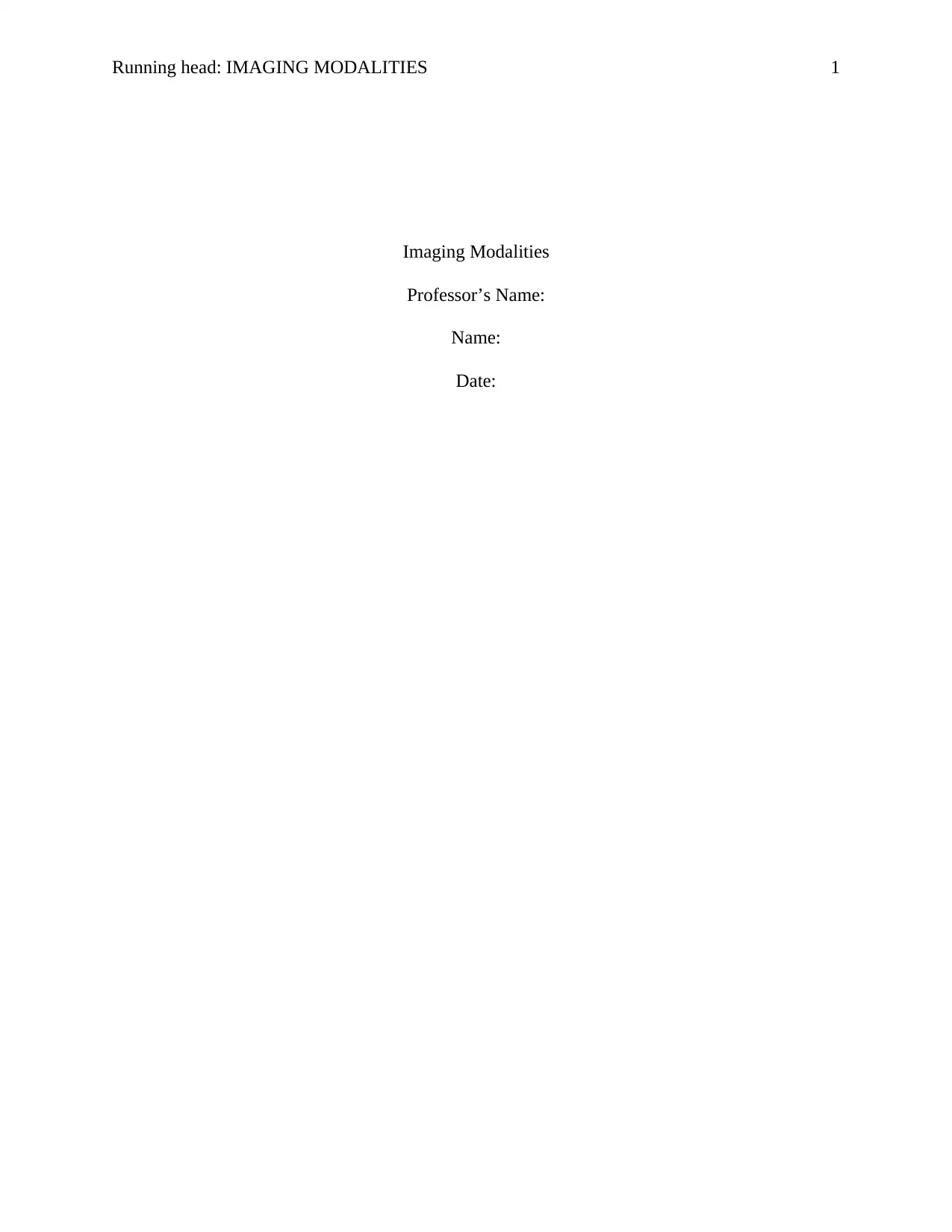
Running head: IMAGING MODALITIES 1
Imaging Modalities
Professor’s Name:
Name:
Date:
Imaging Modalities
Professor’s Name:
Name:
Date:
Paraphrase This Document
Need a fresh take? Get an instant paraphrase of this document with our AI Paraphraser
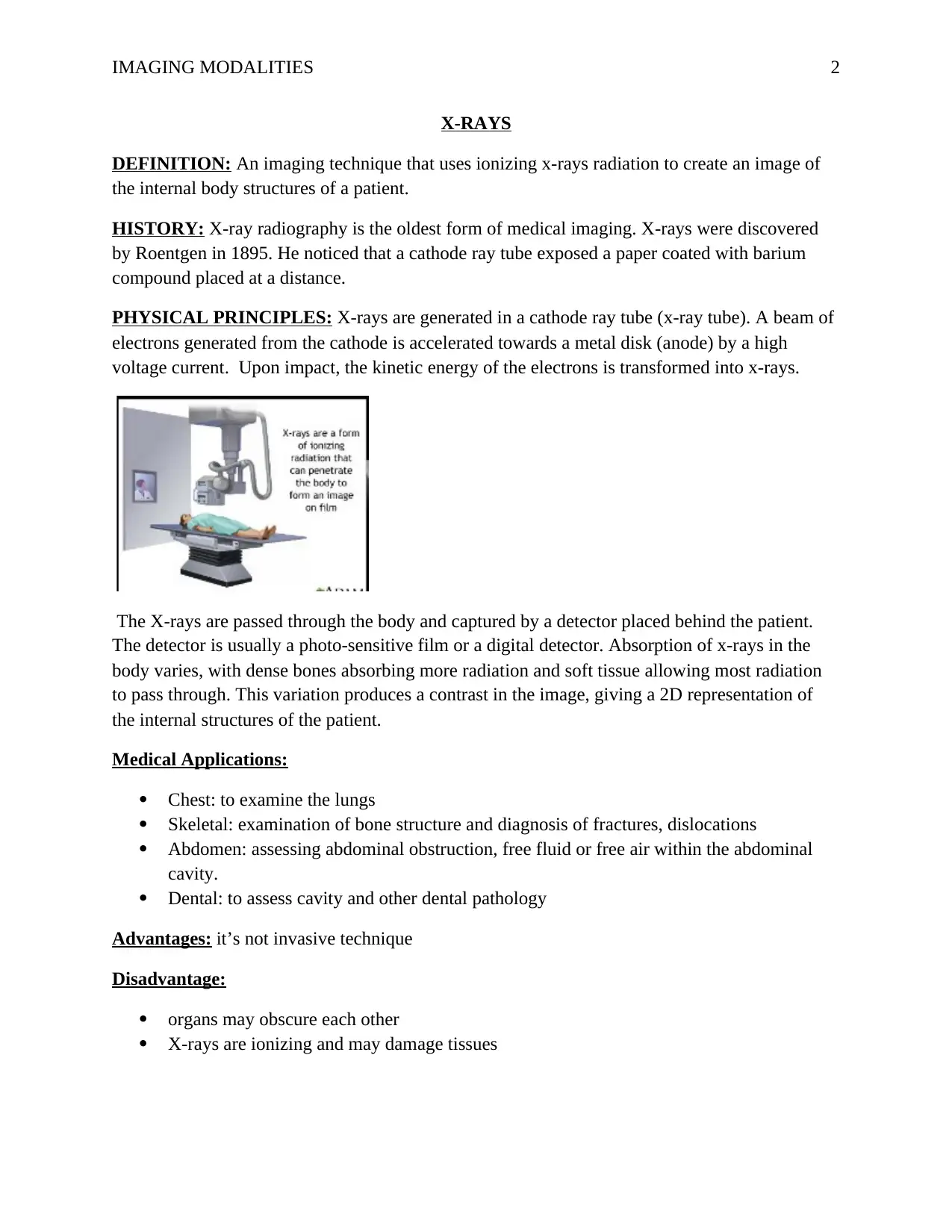
IMAGING MODALITIES 2
X-RAYS
DEFINITION: An imaging technique that uses ionizing x-rays radiation to create an image of
the internal body structures of a patient.
HISTORY: X-ray radiography is the oldest form of medical imaging. X-rays were discovered
by Roentgen in 1895. He noticed that a cathode ray tube exposed a paper coated with barium
compound placed at a distance.
PHYSICAL PRINCIPLES: X-rays are generated in a cathode ray tube (x-ray tube). A beam of
electrons generated from the cathode is accelerated towards a metal disk (anode) by a high
voltage current. Upon impact, the kinetic energy of the electrons is transformed into x-rays.
The X-rays are passed through the body and captured by a detector placed behind the patient.
The detector is usually a photo-sensitive film or a digital detector. Absorption of x-rays in the
body varies, with dense bones absorbing more radiation and soft tissue allowing most radiation
to pass through. This variation produces a contrast in the image, giving a 2D representation of
the internal structures of the patient.
Medical Applications:
Chest: to examine the lungs
Skeletal: examination of bone structure and diagnosis of fractures, dislocations
Abdomen: assessing abdominal obstruction, free fluid or free air within the abdominal
cavity.
Dental: to assess cavity and other dental pathology
Advantages: it’s not invasive technique
Disadvantage:
organs may obscure each other
X-rays are ionizing and may damage tissues
X-RAYS
DEFINITION: An imaging technique that uses ionizing x-rays radiation to create an image of
the internal body structures of a patient.
HISTORY: X-ray radiography is the oldest form of medical imaging. X-rays were discovered
by Roentgen in 1895. He noticed that a cathode ray tube exposed a paper coated with barium
compound placed at a distance.
PHYSICAL PRINCIPLES: X-rays are generated in a cathode ray tube (x-ray tube). A beam of
electrons generated from the cathode is accelerated towards a metal disk (anode) by a high
voltage current. Upon impact, the kinetic energy of the electrons is transformed into x-rays.
The X-rays are passed through the body and captured by a detector placed behind the patient.
The detector is usually a photo-sensitive film or a digital detector. Absorption of x-rays in the
body varies, with dense bones absorbing more radiation and soft tissue allowing most radiation
to pass through. This variation produces a contrast in the image, giving a 2D representation of
the internal structures of the patient.
Medical Applications:
Chest: to examine the lungs
Skeletal: examination of bone structure and diagnosis of fractures, dislocations
Abdomen: assessing abdominal obstruction, free fluid or free air within the abdominal
cavity.
Dental: to assess cavity and other dental pathology
Advantages: it’s not invasive technique
Disadvantage:
organs may obscure each other
X-rays are ionizing and may damage tissues
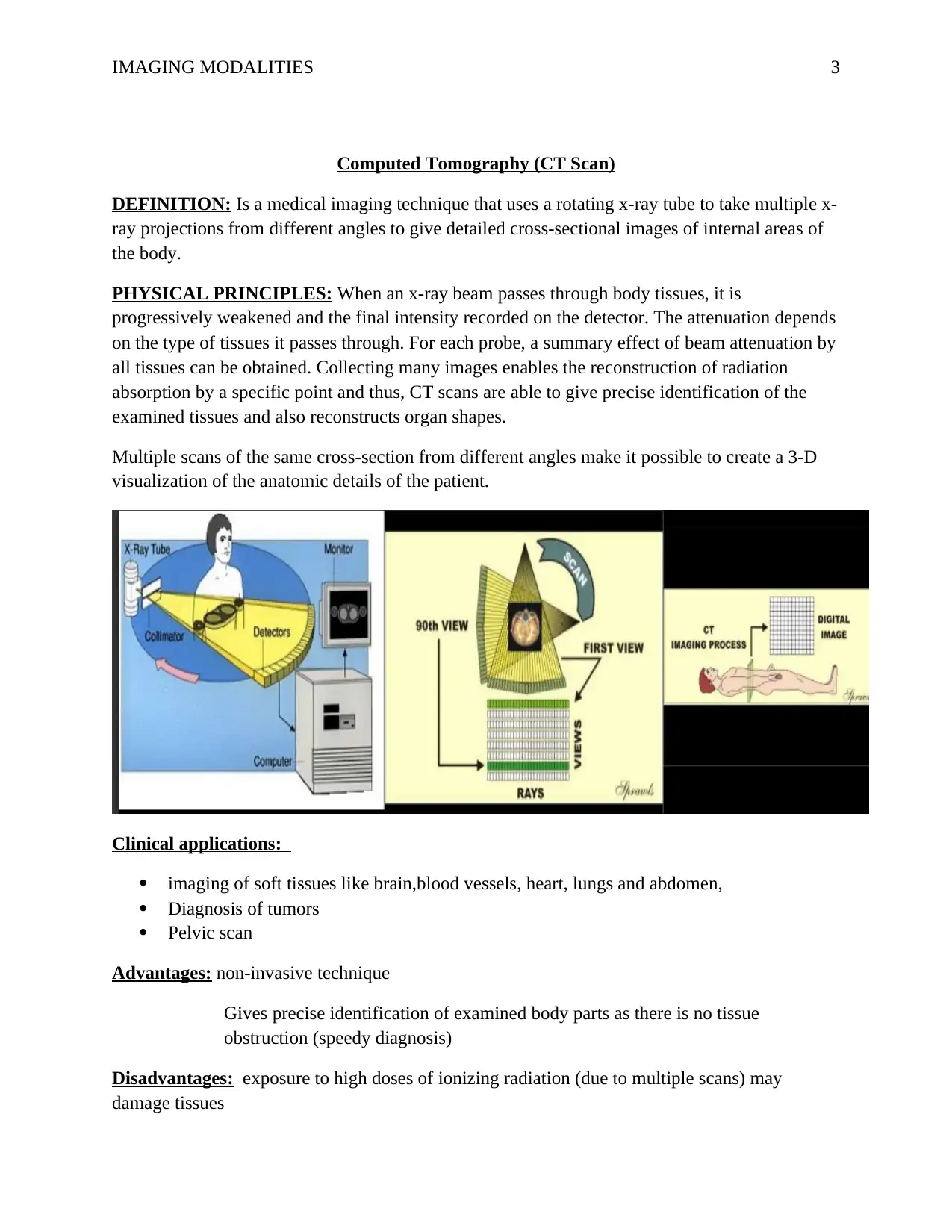
IMAGING MODALITIES 3
Computed Tomography (CT Scan)
DEFINITION: Is a medical imaging technique that uses a rotating x-ray tube to take multiple x-
ray projections from different angles to give detailed cross-sectional images of internal areas of
the body.
PHYSICAL PRINCIPLES: When an x-ray beam passes through body tissues, it is
progressively weakened and the final intensity recorded on the detector. The attenuation depends
on the type of tissues it passes through. For each probe, a summary effect of beam attenuation by
all tissues can be obtained. Collecting many images enables the reconstruction of radiation
absorption by a specific point and thus, CT scans are able to give precise identification of the
examined tissues and also reconstructs organ shapes.
Multiple scans of the same cross-section from different angles make it possible to create a 3-D
visualization of the anatomic details of the patient.
Clinical applications:
imaging of soft tissues like brain,blood vessels, heart, lungs and abdomen,
Diagnosis of tumors
Pelvic scan
Advantages: non-invasive technique
Gives precise identification of examined body parts as there is no tissue
obstruction (speedy diagnosis)
Disadvantages: exposure to high doses of ionizing radiation (due to multiple scans) may
damage tissues
Computed Tomography (CT Scan)
DEFINITION: Is a medical imaging technique that uses a rotating x-ray tube to take multiple x-
ray projections from different angles to give detailed cross-sectional images of internal areas of
the body.
PHYSICAL PRINCIPLES: When an x-ray beam passes through body tissues, it is
progressively weakened and the final intensity recorded on the detector. The attenuation depends
on the type of tissues it passes through. For each probe, a summary effect of beam attenuation by
all tissues can be obtained. Collecting many images enables the reconstruction of radiation
absorption by a specific point and thus, CT scans are able to give precise identification of the
examined tissues and also reconstructs organ shapes.
Multiple scans of the same cross-section from different angles make it possible to create a 3-D
visualization of the anatomic details of the patient.
Clinical applications:
imaging of soft tissues like brain,blood vessels, heart, lungs and abdomen,
Diagnosis of tumors
Pelvic scan
Advantages: non-invasive technique
Gives precise identification of examined body parts as there is no tissue
obstruction (speedy diagnosis)
Disadvantages: exposure to high doses of ionizing radiation (due to multiple scans) may
damage tissues
⊘ This is a preview!⊘
Do you want full access?
Subscribe today to unlock all pages.

Trusted by 1+ million students worldwide
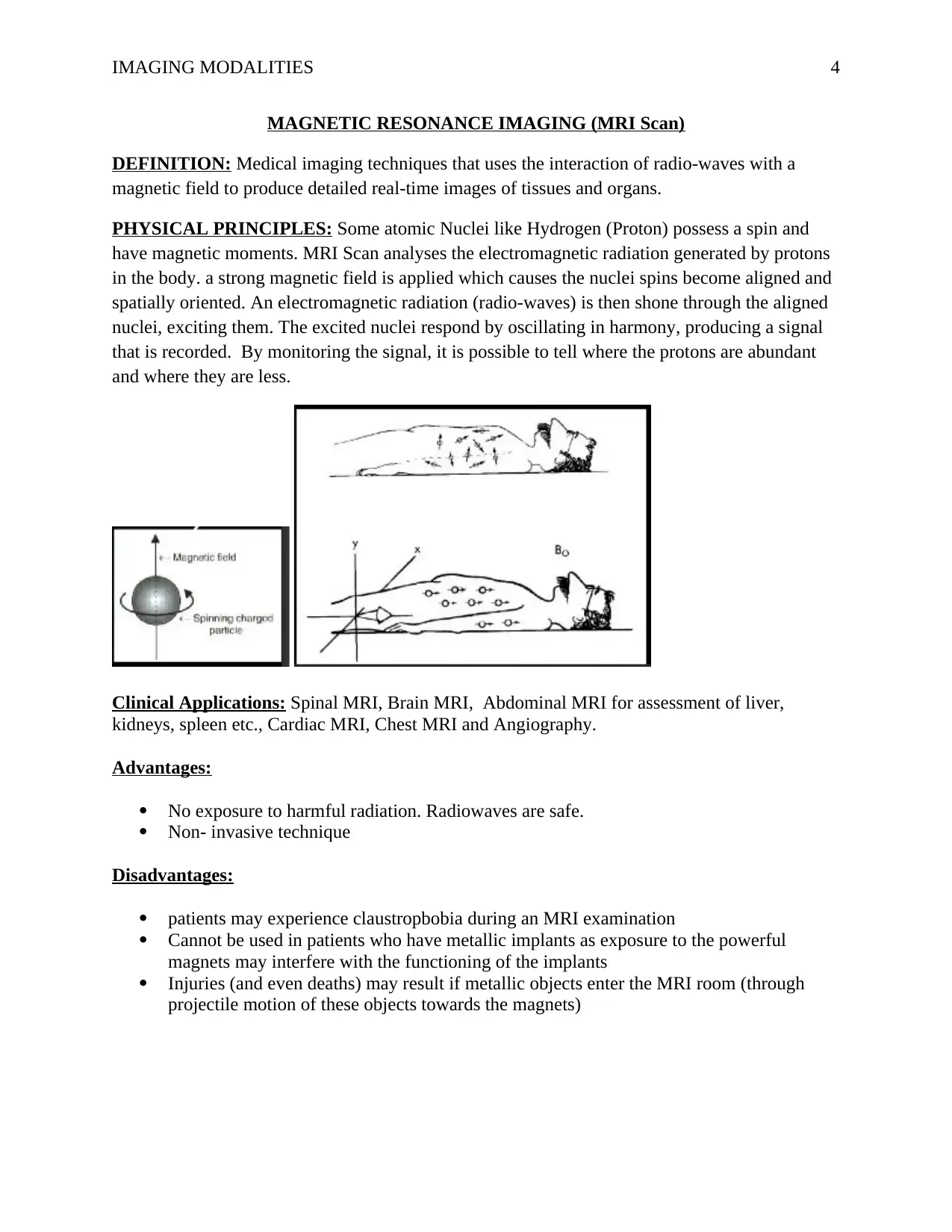
IMAGING MODALITIES 4
MAGNETIC RESONANCE IMAGING (MRI Scan)
DEFINITION: Medical imaging techniques that uses the interaction of radio-waves with a
magnetic field to produce detailed real-time images of tissues and organs.
PHYSICAL PRINCIPLES: Some atomic Nuclei like Hydrogen (Proton) possess a spin and
have magnetic moments. MRI Scan analyses the electromagnetic radiation generated by protons
in the body. a strong magnetic field is applied which causes the nuclei spins become aligned and
spatially oriented. An electromagnetic radiation (radio-waves) is then shone through the aligned
nuclei, exciting them. The excited nuclei respond by oscillating in harmony, producing a signal
that is recorded. By monitoring the signal, it is possible to tell where the protons are abundant
and where they are less.
Clinical Applications: Spinal MRI, Brain MRI, Abdominal MRI for assessment of liver,
kidneys, spleen etc., Cardiac MRI, Chest MRI and Angiography.
Advantages:
No exposure to harmful radiation. Radiowaves are safe.
Non- invasive technique
Disadvantages:
patients may experience claustropbobia during an MRI examination
Cannot be used in patients who have metallic implants as exposure to the powerful
magnets may interfere with the functioning of the implants
Injuries (and even deaths) may result if metallic objects enter the MRI room (through
projectile motion of these objects towards the magnets)
MAGNETIC RESONANCE IMAGING (MRI Scan)
DEFINITION: Medical imaging techniques that uses the interaction of radio-waves with a
magnetic field to produce detailed real-time images of tissues and organs.
PHYSICAL PRINCIPLES: Some atomic Nuclei like Hydrogen (Proton) possess a spin and
have magnetic moments. MRI Scan analyses the electromagnetic radiation generated by protons
in the body. a strong magnetic field is applied which causes the nuclei spins become aligned and
spatially oriented. An electromagnetic radiation (radio-waves) is then shone through the aligned
nuclei, exciting them. The excited nuclei respond by oscillating in harmony, producing a signal
that is recorded. By monitoring the signal, it is possible to tell where the protons are abundant
and where they are less.
Clinical Applications: Spinal MRI, Brain MRI, Abdominal MRI for assessment of liver,
kidneys, spleen etc., Cardiac MRI, Chest MRI and Angiography.
Advantages:
No exposure to harmful radiation. Radiowaves are safe.
Non- invasive technique
Disadvantages:
patients may experience claustropbobia during an MRI examination
Cannot be used in patients who have metallic implants as exposure to the powerful
magnets may interfere with the functioning of the implants
Injuries (and even deaths) may result if metallic objects enter the MRI room (through
projectile motion of these objects towards the magnets)
Paraphrase This Document
Need a fresh take? Get an instant paraphrase of this document with our AI Paraphraser
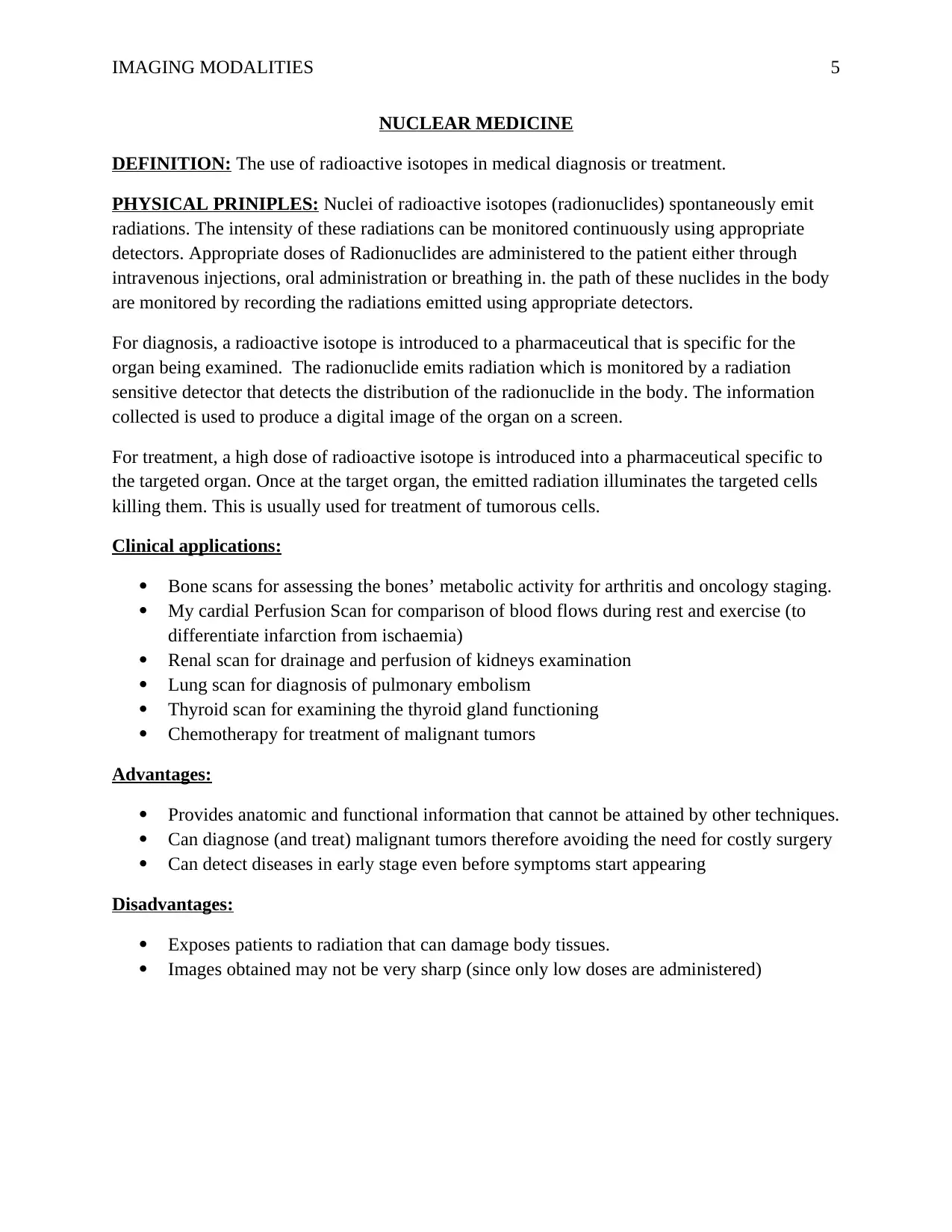
IMAGING MODALITIES 5
NUCLEAR MEDICINE
DEFINITION: The use of radioactive isotopes in medical diagnosis or treatment.
PHYSICAL PRINIPLES: Nuclei of radioactive isotopes (radionuclides) spontaneously emit
radiations. The intensity of these radiations can be monitored continuously using appropriate
detectors. Appropriate doses of Radionuclides are administered to the patient either through
intravenous injections, oral administration or breathing in. the path of these nuclides in the body
are monitored by recording the radiations emitted using appropriate detectors.
For diagnosis, a radioactive isotope is introduced to a pharmaceutical that is specific for the
organ being examined. The radionuclide emits radiation which is monitored by a radiation
sensitive detector that detects the distribution of the radionuclide in the body. The information
collected is used to produce a digital image of the organ on a screen.
For treatment, a high dose of radioactive isotope is introduced into a pharmaceutical specific to
the targeted organ. Once at the target organ, the emitted radiation illuminates the targeted cells
killing them. This is usually used for treatment of tumorous cells.
Clinical applications:
Bone scans for assessing the bones’ metabolic activity for arthritis and oncology staging.
My cardial Perfusion Scan for comparison of blood flows during rest and exercise (to
differentiate infarction from ischaemia)
Renal scan for drainage and perfusion of kidneys examination
Lung scan for diagnosis of pulmonary embolism
Thyroid scan for examining the thyroid gland functioning
Chemotherapy for treatment of malignant tumors
Advantages:
Provides anatomic and functional information that cannot be attained by other techniques.
Can diagnose (and treat) malignant tumors therefore avoiding the need for costly surgery
Can detect diseases in early stage even before symptoms start appearing
Disadvantages:
Exposes patients to radiation that can damage body tissues.
Images obtained may not be very sharp (since only low doses are administered)
NUCLEAR MEDICINE
DEFINITION: The use of radioactive isotopes in medical diagnosis or treatment.
PHYSICAL PRINIPLES: Nuclei of radioactive isotopes (radionuclides) spontaneously emit
radiations. The intensity of these radiations can be monitored continuously using appropriate
detectors. Appropriate doses of Radionuclides are administered to the patient either through
intravenous injections, oral administration or breathing in. the path of these nuclides in the body
are monitored by recording the radiations emitted using appropriate detectors.
For diagnosis, a radioactive isotope is introduced to a pharmaceutical that is specific for the
organ being examined. The radionuclide emits radiation which is monitored by a radiation
sensitive detector that detects the distribution of the radionuclide in the body. The information
collected is used to produce a digital image of the organ on a screen.
For treatment, a high dose of radioactive isotope is introduced into a pharmaceutical specific to
the targeted organ. Once at the target organ, the emitted radiation illuminates the targeted cells
killing them. This is usually used for treatment of tumorous cells.
Clinical applications:
Bone scans for assessing the bones’ metabolic activity for arthritis and oncology staging.
My cardial Perfusion Scan for comparison of blood flows during rest and exercise (to
differentiate infarction from ischaemia)
Renal scan for drainage and perfusion of kidneys examination
Lung scan for diagnosis of pulmonary embolism
Thyroid scan for examining the thyroid gland functioning
Chemotherapy for treatment of malignant tumors
Advantages:
Provides anatomic and functional information that cannot be attained by other techniques.
Can diagnose (and treat) malignant tumors therefore avoiding the need for costly surgery
Can detect diseases in early stage even before symptoms start appearing
Disadvantages:
Exposes patients to radiation that can damage body tissues.
Images obtained may not be very sharp (since only low doses are administered)
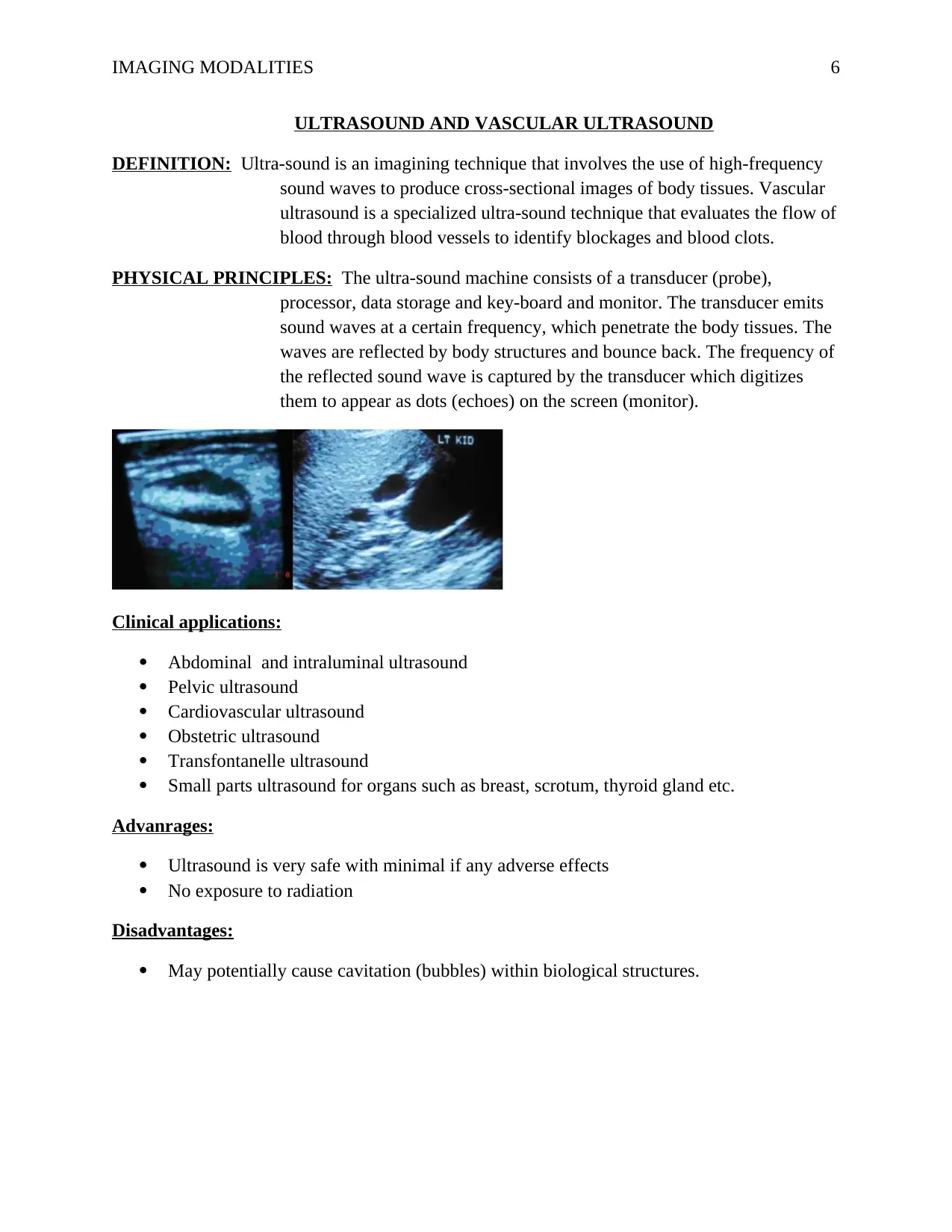
IMAGING MODALITIES 6
ULTRASOUND AND VASCULAR ULTRASOUND
DEFINITION: Ultra-sound is an imagining technique that involves the use of high-frequency
sound waves to produce cross-sectional images of body tissues. Vascular
ultrasound is a specialized ultra-sound technique that evaluates the flow of
blood through blood vessels to identify blockages and blood clots.
PHYSICAL PRINCIPLES: The ultra-sound machine consists of a transducer (probe),
processor, data storage and key-board and monitor. The transducer emits
sound waves at a certain frequency, which penetrate the body tissues. The
waves are reflected by body structures and bounce back. The frequency of
the reflected sound wave is captured by the transducer which digitizes
them to appear as dots (echoes) on the screen (monitor).
Clinical applications:
Abdominal and intraluminal ultrasound
Pelvic ultrasound
Cardiovascular ultrasound
Obstetric ultrasound
Transfontanelle ultrasound
Small parts ultrasound for organs such as breast, scrotum, thyroid gland etc.
Advanrages:
Ultrasound is very safe with minimal if any adverse effects
No exposure to radiation
Disadvantages:
May potentially cause cavitation (bubbles) within biological structures.
ULTRASOUND AND VASCULAR ULTRASOUND
DEFINITION: Ultra-sound is an imagining technique that involves the use of high-frequency
sound waves to produce cross-sectional images of body tissues. Vascular
ultrasound is a specialized ultra-sound technique that evaluates the flow of
blood through blood vessels to identify blockages and blood clots.
PHYSICAL PRINCIPLES: The ultra-sound machine consists of a transducer (probe),
processor, data storage and key-board and monitor. The transducer emits
sound waves at a certain frequency, which penetrate the body tissues. The
waves are reflected by body structures and bounce back. The frequency of
the reflected sound wave is captured by the transducer which digitizes
them to appear as dots (echoes) on the screen (monitor).
Clinical applications:
Abdominal and intraluminal ultrasound
Pelvic ultrasound
Cardiovascular ultrasound
Obstetric ultrasound
Transfontanelle ultrasound
Small parts ultrasound for organs such as breast, scrotum, thyroid gland etc.
Advanrages:
Ultrasound is very safe with minimal if any adverse effects
No exposure to radiation
Disadvantages:
May potentially cause cavitation (bubbles) within biological structures.
⊘ This is a preview!⊘
Do you want full access?
Subscribe today to unlock all pages.

Trusted by 1+ million students worldwide

IMAGING MODALITIES 7
References
http://www.who.int/diagnostic_imaging/imaging_modalities/dim_plain-radiography/en/
index5.html
http://www.medicalimaging.org/about-mita/medical-imaging-primer/
References
http://www.who.int/diagnostic_imaging/imaging_modalities/dim_plain-radiography/en/
index5.html
http://www.medicalimaging.org/about-mita/medical-imaging-primer/
1 out of 7
Related Documents
Your All-in-One AI-Powered Toolkit for Academic Success.
+13062052269
info@desklib.com
Available 24*7 on WhatsApp / Email
![[object Object]](/_next/static/media/star-bottom.7253800d.svg)
Unlock your academic potential
Copyright © 2020–2025 A2Z Services. All Rights Reserved. Developed and managed by ZUCOL.





